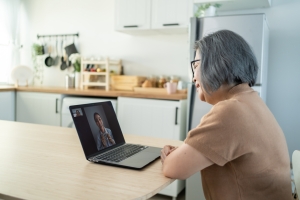By Kirsten Weir
If you or a family member is managing chronic kidney disease, you’re probably thinking a lot about physical health—the health of the kidney and the rest of the body. Caring for your behavioral health is just as important. And with telehealth options that let you see a behavioral health professional from your home, it’s more convenient than ever.
“The increased availability and acceptance of telehealth might be one of the few positive changes to come out of the [COVID-19] pandemic,” says Amy Walters, PhD, a clinical health psychologist and the director of Behavioral Health Services for St. Luke’s Humphreys Diabetes Center.
There are very good reasons to establish care with a behavioral health professional, Walters adds. “Living with chronic disease is stressful. And having a mental health provider on your team is an asset,” she says.
When should you see a behavioral health professional?
Kidney disease comes with a lot of challenges. Psychologists or other behavioral health professionals can help in many ways. They can work with you to develop positive coping skills and support you in making healthy lifestyle changes (like taking your medicine on time or changing your diet). Chronic illness can put a strain on relationships with family and friends, and behavioral health professionals can help you manage those social relationships, too. They can also treat illnesses like anxiety and depression, which are more common in adults and children with chronic illnesses.
Seeing a psychologist doesn’t have to be a long-term commitment, Walters adds. “Even having just a few appointments can be helpful for learning some basic coping strategies,” she says. And if other challenges arise later, you’ll already have a relationship with a psychologist. “You can return to care as often as needed,” she says.
Traditionally, that care took place in a behavioral health professional’s office. Now, telehealth has become the norm. Telehealth, also known as telemedicine, lets you connect with your provider from anywhere. “Telehealth brings the [mental health] provider into your home,” says Marlene Maheu, PhD, a clinical psychologist and founder of Telehealth.org.
The Pros and Cons of Telehealth
Telemedicine appointments are usually conducted online using videoconferencing. (Sometimes, though, telehealth is delivered over the phone without video.) Early research shows that video telehealth for behavioral health is as effective as in-person psychotherapy. And telehealth has a lot of benefits:
- Access: Telehealth gives you the chance to see behavioral health professionals across your state (and sometimes beyond). This is especially helpful for people in remote or rural areas, where there aren’t many psychologists available. Telehealth also improves access to specialists. There may not be a psychologist in your region who has experience helping patients manage chronic illnesses, for example, or who specializes in treating children. With telehealth, you can see specialists in other cities who meet your needs.
- Safety: With COVID-19 still circulating, some people prefer to limit their exposure to public spaces, particularly kidney transplant recipients who take immunosuppressing medication. Telehealth is a safe way to access services without having to take a bus or sit in a clinic waiting room. And “COVID isn’t the only virus to consider,” Walters says. During cold and flu season, telehealth can limit your exposure to other illnesses, too.
- Convenience: Traveling to a behavioral health appointment can mean taking time off work, traveling to and from the clinic, and paying for transportation or parking. If you have children, you might have to arrange a babysitter while you’re at your appointment. Such factors can make it hard to work psychotherapy into your schedule. Telehealth eliminates the travel time and other obstacles that can interfere with planning an appointment.
- Comfort: Many people are more comfortable on their own turf. Discussing sensitive topics with a behavioral health provider might seem easier when you’re surrounded by the comforts of home.
While telehealth has a lot going for it, it isn’t for everyone. Because services are delivered over the computer or the phone, it might not be the best choice for people who have unreliable technology or trouble using a computer.
Some people find it harder to form a connection with a behavioral health provider when they aren’t in the same room. That can be especially true for young children, or for people with vision or hearing problems. Those are factors to think about when considering telehealth, Walters says. “But for most people, the positives of telehealth outweigh the negatives,” she adds.
How to Find the Right Telehealth Provider
If you’re ready to look for a behavioral health provider, start by asking members of your medical team. They may be able to recommend psychologists or other professionals who could see you by telehealth. You could get recommendations from friends or family members. And the APA Psychologist Locator can also help you find a psychologist near you.
While telehealth makes it possible to see a provider hundreds of miles away, it’s important to see someone who is licensed to provide care in the state you’re in. It’s also a good idea to look for someone who has been trained in telehealth, says Kenneth Drude, PhD, a clinical psychologist and professor at Wright State University. “Especially during the pandemic, a lot of people jumped into telehealth,” he says. “To ensure quality care, you should ask about what kind of training they’ve had in providing telehealth services.”
Many experts recommend meeting with two or three different behavioral health providers before deciding which is the right fit for you. You want to find someone that you feel comfortable with, so you can speak honestly and be yourself. “It’s not necessarily about who you like best, but who you think will be the best fit for taking you where you want to go,” Maheu says.
 Preparing for a Telehealth Behavioral Health Visit
Preparing for a Telehealth Behavioral Health Visit
Your first visit with a psychologist will be similar whether you’re in person or on a video call. During your first meeting, you’ll focus on getting to know one another. You can let your provider know your concerns and goals. Together you can discuss a plan for moving forward.
When preparing for your telehealth visit, there are some things you can do to help it go smoothly. First, familiarize yourself with the technology. Your provider’s office will give you instructions about how to log into the appointment at your scheduled time. If you have questions or have trouble logging on, reach out to your provider’s office with questions.
Many behavioral health providers send questionnaires before your first appointment. Filling these out ahead of time lets your provider learn a bit about you and your background.
When the time comes for your appointment, find a quiet location where you can have a private conversation. The fewer the distractions, the more valuable your session will be.
You might feel a little anxious about seeing a behavioral health provider for the first time. But it’s often easier when you can do it from the comfort and safety of your own home. And most people who see a behavioral health professional are glad they did. “That individual is there to listen to you, to understand your challenges and to help you make a plan for next steps,” Walters says. “It’s one more piece of the puzzle in taking care of your overall health.”
Kirsten Weir is a health and science writer and regular content contributor for the American Psychological Association.
This resource was developed jointly by the American Psychological Association (APA) and Dialysis Patient Citizens Education Center as part of a partnership to educate dialysis patients and their families on the psychological and emotional aspects of managing kidney disease.




